9443 A CARVED OAK CENTER TABLE IN THE MANNER OF RICHARD BRIDGENS WITH INSET PARCHIN KARI MARBLE TOP The Top Probably Agra. Seventeenth Century. The Base English. Second Quarter Of The Nineteenth Century. Measurements: Height: 29 1/2″ (74.8 cm) Width: 37 1/2″ (95.1 cm) Depth: 24 1/2″ (62.2 cm)

Research
Of oak. The rectangular top with molded edge inset with a white marble panel inlaid with various colored marbles in a geometric pattern decorated with stylized flowers and leaves, the top above a shaped apron and raised on four turned legs headed by volutes with scale-carving and united by four square stretchers.
Parchin kari, the Mughal word for pietre dure, translates literally to “inlay-“ or “driven-in,” and the technique was performed by inlayers, or parchinkars.1 The art of inlay developed independently in India, but was possibly influenced by Italian craftsmen at the Mughal court.2 In the age of Shah Jahan, the 17th-century Mughal emperor, architecture was evolving from grounds of red sandstone to white marble, and from relief carving to inlay with rare and semiprecious stones in floral and arabesque motifs.3
The most famous Mughal building to feature parchin kari is the Taj Mahal. Considered the finest example of Mughal architecture, the Taj Mahal was built between 1632 and 1653 by Shah Jahan as a mausoleum for his wife, Mumtaz Mahal. “The gemstones and ornamental stones used for the inlaid decoration of the mausoleum interior spaces are used to create calligraphic, floral and abstract geometric designs” with the floral motifs in particular being the most prevalent and expressing imperial presence.4 As can be seen in figure 1, the parchin kari of the Taj Mahal employs the same angular and curvilinear lines as the design of the present table top, and is embellished with similar three- and five-petaled flowers, buds, and leaves.
Another closely related panel is located in the Victoria and Albert Museum collection (figure 2). Dating from circa 1640, this panel was probably made in Agra and contains “a range of semi-precious stones, including nephrite jade from Kashgar and Khotan, lapis lazuli from Afghanistan, and stones such as carnelian, heliotrope and agate from various regions in the Indian subcontinent.”5 Both the present tabletop and the V&A panel share a border of yellow and black inlaid lines that surround the strapwork and floral designs. Also of note are two discreet repairs, one square and one circular, around two of the flowers on the present tabletop. The V&A frieze panel bears very similar circular repairs around three of its flowers.
The base of the present table, constructed specifically for these precious inlaid panels, harks back to 17th-century design precedents, and complements the parchin kari design of the top. The base is designed in the manner of Richard Bridgens, 19th-century English architect, designer and artist. He worked for contemporaries George Bullock and James Watt furnishing such residences as Battle Abbey in East Sussex for Sir Godfrey Vassal Webster; Abbotsford House, home of Sir Walter Scott; and Aston Hall in Birmingham. Bridgens is known for his designs in the gothic, Elizabethan and Jacobean styles.
Footnotes:
1. Nath, Ravinder. History of Mughal Architecture: History of Mughal. Vol. IV. Part I. Minneapolis: Abhinav Publications, 2006. 326.
2. Kennedy, Thalia. “The Notion of Hierarchy: The ‘Parchin Kari’ Programme at the Taj Mahal.” International Journal of Architectural Research 1 (2007): 105-21.
3. Nath, 142.
4. Kennedy, 105-121.
5. “Frieze panel (1534-1855) – Collections V&A.” Search the Collections – Collections V&A. Victoria and Albert Museum. 18 Mar. 2009 <http://collections.vam.ac.uk/objectid/O15486>.

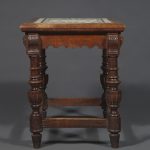
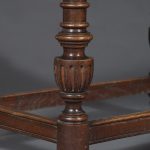
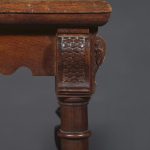
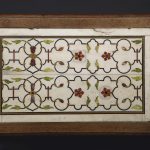
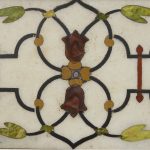
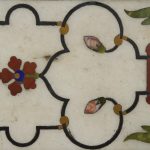
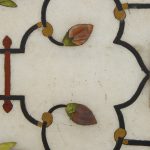
Comments are closed.